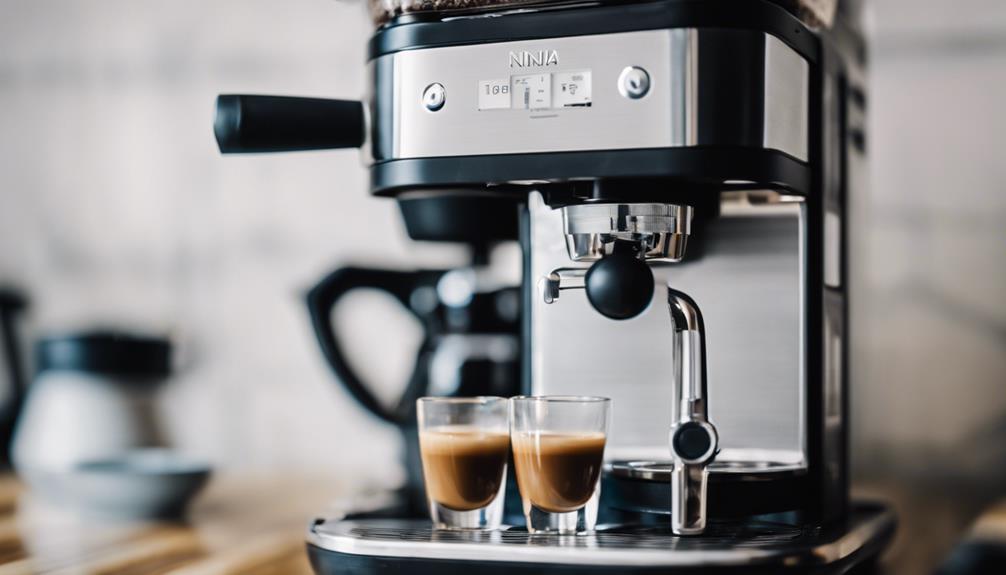Espresso has a thick texture due to factors such as high-pressure extraction, blending oils and solids, fine coffee grind, and increased extraction surface area. The high pressure used in brewing creates a flavorful mixture by extracting more soluble solids. Emulsification combines oils and solids to add richness to the drink. A fine grind contributes to better extraction, while compact grounds ensure even water flow. Well-made espresso has a viscosity similar to warm honey, with a creamy mouthfeel from the oils. The thickness and flavor of espresso result from a combination of grind size, pressure, and extraction. Exploring these details will give you a deeper understanding of what makes espresso unique.
Key Takeaways
- High-pressure extraction under 9 bars results in a thick, flavorful espresso with crema.
- Emulsification of oils and solids through high pressure creates a homogenous, rich texture.
- Fine grind of coffee beans increases extraction efficiency, leading to a velvety espresso.
- Increased surface area from finely ground coffee aids in a concentrated flavor profile.
- Well-executed extraction process, including tamping and pressure, contributes to the sought-after thick texture.
High Pressure Extraction
If you've ever wondered why espresso is so thick, it's all thanks to the high-pressure extraction process it undergoes. When brewing espresso, it's typically done at 9 bars of pressure, much higher than regular coffee brewing methods. This high pressure forces hot water through finely ground coffee at a rapid rate, resulting in a concentrated and viscous liquid known as espresso.
The key to the thickness of espresso lies in this high pressure extraction. By subjecting the coffee grounds to such intense pressure, more soluble solids are extracted from the beans, creating a dense and rich beverage. This process also contributes to the formation of the crema, a signature layer of emulsified oils and gases that sits atop a well-brewed espresso.
In essence, the combination of high pressure, the fineness of the coffee grind, and the precise extraction time all work together to produce the thick and flavorful espresso that many enjoy.
Emulsification of Oils and Solids

The emulsification of oils and solids in espresso plays an important role in creating its thick and creamy texture. When oils and solids combine through emulsification during the brewing process, they form a harmonious blend that contributes to the luxurious mouthfeel of espresso.
Here are five key points to keep in mind regarding emulsification in espresso:
- Emulsification is the process of mixing oils and solids to create a homogenous mixture.
- Oils released from coffee beans during extraction contribute to the richness of espresso.
- The high pressure used in espresso machines aids in emulsifying the oils, enhancing the overall texture.
- Emulsification also leads to the formation of crema, the coveted golden foam atop a well-extracted shot.
- Achieving the right balance of oils and solids is essential for obtaining the desired thickness and flavor in espresso.
Fine Grind of Coffee Beans

Emulsification of oils and solids in espresso sets the stage for understanding the importance of a fine grind of coffee beans. When preparing espresso, the significance of the coffee grind plays a pivotal role in achieving that rich and thick consistency you love. A fine grind, specifically tailored for espresso brewing, enhances the extraction process by increasing the surface area of the coffee grounds, allowing the hot water to extract flavors and oils efficiently. This results in a concentrated and velvety brew that embodies the essence of espresso.
To visualize the impact of a fine grind, let's compare different grind sizes in the table below:
| Grind Size | Extraction Efficiency | Espresso Texture |
|---|---|---|
| Coarse | Low | Thin and watery |
| Medium | Moderate | Balanced texture |
| Fine | High | Thick and velvety |
Increased Surface Area for Extraction

When the coffee grounds are finely ground for espresso, they create a larger surface area for water to extract flavor compounds.
This increased surface area allows for more efficient extraction, resulting in a concentrated and flavorful espresso.
Extraction Efficiency
To enhance extraction efficiency in espresso preparation, maximizing the surface area for extraction is essential. Finely ground coffee particles allow for more contact with water, ensuring a thorough extraction process.
When the coffee grounds are tightly compacted into a puck in the portafilter, it aids in creating an even distribution of water, leading to a consistent extraction of flavors. The high pressure in espresso machines pushes hot water through the compacted coffee grounds, extracting a higher concentration of oils and flavors.
This process results in the formation of emulsified oils and dissolved solids, which contribute to the dense and velvety texture of espresso. Extraction efficiency is a critical factor in achieving the rich and intense flavors characteristic of espresso.
Flavor Concentration
One key factor contributing to the thick texture of espresso is the increased surface area for extraction achieved through finely ground coffee beans. When coffee beans are finely ground for espresso, more surface area is exposed, allowing for a rapid extraction of flavor compounds. This process leads to a concentrated and intense flavor profile that contributes to the thickness of espresso.
The finely ground coffee used in espresso machines, combined with high pressure and short extraction time, results in a unique flavor concentration. The pressure forces water through the finely ground coffee, extracting oils and solids that add to the thick texture of espresso. Compared to other brewing methods, espresso's short extraction time plays a significant role in its intense and viscous nature.
In essence, the combination of finely ground coffee, high pressure, and short extraction time creates the distinctive flavor concentration that makes espresso thick and flavorful.
Concentrated Flavor Profile

Espresso offers a bold flavor concentration, creating an intense taste profile that sets it apart from other coffee brews.
The high-pressure extraction process efficiently draws out the complex flavors and aromatic oils from the finely ground coffee, resulting in a rich and robust taste experience.
This concentrated flavor profile is a key characteristic of espresso, providing a full-bodied and satisfying coffee experience that many espresso enthusiasts appreciate.
Bold Flavor Concentration
The concentrated flavor profile of espresso results from the intense extraction process that enhances its boldness and thickness. When you take a sip of espresso, here's why you experience such a bold flavor concentration:
- High pressure extraction: The intense pressure used in brewing espresso forces water through finely ground coffee, extracting oils and solids that contribute to its thick texture.
- Small serving size: The compact size of espresso allows for a more potent and robust flavor concentration, giving you a thicker mouthfeel with every sip.
- Crema formation: The crema on top of espresso adds to its thickness, formed by emulsified oils that enrich the overall sensory experience.
- Factors at play: Elements like grind size, extraction time, and bean quality all come together to create the rich and intense flavor profile that defines espresso.
- Multifaceted process: The combination of these factors showcases how espresso achieves its reputation for bold flavor concentration and thickness.
Intense Taste Profile
To understand the intense taste profile of espresso, consider how the high pressure extraction process influences its concentrated flavor.
When brewing espresso, a small but vital shot of coffee is extracted using a high coffee-to-water ratio, resulting in a rich and intense flavor experience.
The concentrated flavors in espresso are enhanced by its thick texture, which allows for a more pronounced perception of the various flavor compounds present in the coffee beans.
The fine grind size of the beans also plays a pivotal role in achieving espresso's intense taste profile, as it enables maximum extraction of oils and flavors during the brewing process.
Additionally, the crema that forms on top of the espresso further adds to its thickness, creating a creamy and velvety mouthfeel that complements the overall sensory experience.
Essentially, the intense taste profile of espresso is a result of carefully balancing factors like pressure, ratio, grind size, and crema to create a bold and flavorful coffee beverage.
Viscous and Creamy Texture

With a dense and velvety mouthfeel, espresso's viscous and creamy texture is a result of the emulsification process that occurs during extraction. When the fine coffee grounds are subjected to high pressure, the emulsification of oils and colloids takes place, creating a luxurious sensation on your palate. Here are five elements that contribute to espresso's delightful texture:
- The emulsification process blends oils and colloids, enhancing the creamy mouthfeel.
- The fine grind size allows for a higher surface area, promoting the extraction of coffee solids.
- Crema, the golden foam atop espresso, adds a luscious thickness to each sip.
- The balance of coffee solids, oils, and gases results in a unique viscosity that coats your tongue.
- Concentrated coffee compounds from the extraction process contribute to a dense and intense flavor profile that lingers on your taste buds.
Characteristics of a Well-Made Shot

Embrace the essence of a well-made espresso shot by understanding the key characteristics that define its quality and thickness. A well-brewed espresso shot is thick due to the high concentration of coffee oils and solids extracted under pressure. The crema, a golden layer that sits atop the espresso, adds to its thickness by capturing carbon dioxide and coffee oils, enhancing the overall texture. The pressure applied during the extraction process forces water through finely ground coffee, resulting in a dense and viscous liquid that contributes to the shot's richness. Proper tamping of the coffee grounds in the portafilter is essential to create a uniform surface for water penetration, further enhancing the shot's thickness. Additionally, the ideal brewing time and temperature are vital factors that determine the quality and thickness of the espresso shot.
| Characteristic | Description | Importance |
|---|---|---|
| Thickness | High concentration of coffee oils and solids creates a dense liquid. | Essential for a rich espresso shot. |
| Crema | Golden layer trapping carbon dioxide and coffee oils, adding to thickness. | Contributes to the overall texture. |
| Pressure | Forces water through coffee grounds, resulting in a viscous liquid. | Key factor in achieving a thick espresso shot. |
Impact of Extraction Process

The extraction process greatly influences the thickness of espresso, where hot water is forced through finely ground compacted coffee. Tamping down the coffee grounds helps in guaranteeing uniform water penetration during extraction.
The viscosity of espresso, akin to warm honey, stems from the high pressure and short extraction time involved in its preparation. Achieving the desired thick consistency in espresso hinges on executing the extraction process correctly. The combination of finely ground coffee, high pressure, and precise extraction time plays a pivotal role in creating the distinctively thick texture of espresso.
Proper tamping guarantees even water distribution for a balanced extraction.
The intense pressure applied extracts flavors and oils, enriching the espresso's body.
Viscosity comparable to warm honey results from the high pressure used.
The extraction process is a delicate balance of time, pressure, and grind size.
A well-executed extraction contributes to the sought-after thick and rich espresso texture.
Frequently Asked Questions
Why Is Espresso Thicker Than Coffee?
Espresso is thicker than regular coffee due to the fine grind size, compacted grounds, and the pressure used in the extraction process.
The high pressure brewing method of espresso extraction results in a concentrated and dense coffee with a layer of crema on top. Espresso's viscosity is akin to warm honey, creating a rich mouthfeel.
Additionally, the tamping down of coffee grounds in the portafilter guarantees even water penetration, leading to a flavorful and thick espresso shot.
Why Does Espresso Taste Thick?
Espresso tastes thick due to its concentrated flavor from high pressure extraction. The fine grind size and compacted coffee grounds contribute to its body. Emulsified oils and colloids create a creamy mouthfeel, enhancing thickness perception.
The crema foam layer adds richness. Espresso's higher caffeine content also impacts its perceived thickness. With these elements combined, espresso delivers a robust and thick taste experience that sets it apart from regular coffee.
How Thick Should Espresso Be?
Espresso should be thick like warm honey, a key characteristic influenced by factors like grind size, tamping pressure, shot length, and bean type. Achieving this ideal thickness is vital for flavor balance and mouthfeel, enhancing your coffee experience.
Preferences vary, with some liking a syrupy texture and others a lighter one. Consistency is essential in mastering espresso making. Guarantee your shots are of high quality by aiming for the perfect thickness every time.
Why Is My Espresso Crema Too Thick?
If your espresso crema is too thick, it could be due to various factors such as excessive carbon dioxide in freshly roasted beans, using overly oily beans, or grinding too fine. Properly resting beans after roasting for about a week can help balance crema thickness.
Experimenting with different bean blends and roasts can also influence crema thickness. Adjusting extraction techniques, like tamping pressure and grind size, can be effective in controlling crema thickness.
What Makes the 1zpresso Q2 Grinder Ideal for Thick Espresso?
When it comes to espresso grinding, the 1zpresso Q2 grinder stands out as a top choice for thick espresso lovers. The reasons why q2 great.espresso grinding is due to its precision and consistency in producing the ideal grind size for extracting maximum flavor from your coffee beans.
Conclusion
In summary, the thickness of espresso is a result of the high pressure extraction process, emulsification of oils and solids, fine grind of coffee beans, increased surface area for extraction, concentrated flavor profile, and viscous texture.
A well-made shot will exhibit these characteristics, providing a rich and creamy experience for coffee lovers.
Understanding the impact of the extraction process is essential in appreciating the unique qualities of espresso.
So next time you enjoy a shot, savor the complexity that makes it so special.









